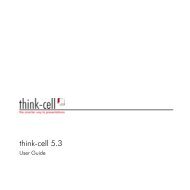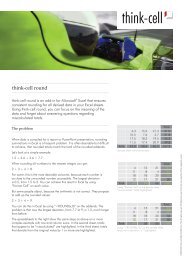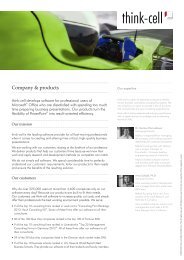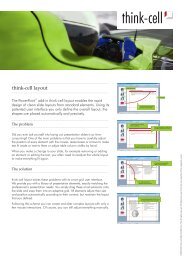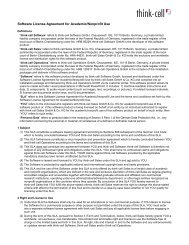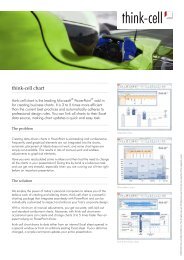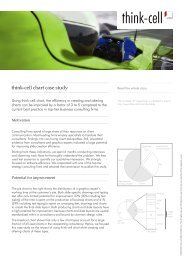think-cell technical report TC2003/01 A GUI-based Interaction ...
think-cell technical report TC2003/01 A GUI-based Interaction ...
think-cell technical report TC2003/01 A GUI-based Interaction ...
Create successful ePaper yourself
Turn your PDF publications into a flip-book with our unique Google optimized e-Paper software.
7.2 Résumé CONCLUSION<br />
User Studies with the Prototype. I did a detailed user study for plain Power-<br />
Point (Chap. 2), whereas only a small case study could be conducted on the smart<br />
grid prototype (Sect. 6.2). As soon as the prototype can be used to create real-life<br />
slides, studies with real users will shed more light on the strengths and weaknesses<br />
of the smart grid approach and will help to refine the interaction concept.<br />
Online User Interface Evaluation. In the current PowerPoint add-in, an online<br />
error <strong>report</strong> is used to help finding bugs that occur at the customer’s site. A<br />
similar feature could facilitate the continued improvement of the user interface:<br />
Data about the frequency and the context of the usage of certain features could<br />
be collected during productive use of the software. This data would help to refine<br />
the software developer’s model of the user population and would help to discover<br />
usability problems without the need for an intrusive user study. It is understood<br />
that a technique like this requires informed consent from the user’s part.<br />
Other Application Domains. The smart grid approach could probably be ex-<br />
tended to other application domains than business slide layout. For example, the<br />
design of graphical user interfaces – which is an active field of research – could<br />
benefit from the experiences that were made with the smart grid implementation.<br />
7.2 Résumé<br />
User interfaces for standard software are typically targeted at a large and diverse<br />
user population and a broad range of possible tasks. In this respect, Microsoft<br />
PowerPoint is a good example: Almost anybody who has used a personal computer<br />
before, can create PowerPoint slides with reasonable effort. There is no doubt<br />
that the PowerPoint user interface is effective for a user population that includes<br />
occasional users as well as professionals. However, the efficiency for a specialized<br />
task, like business slide design, suffers from the attempt to serve everybody well.<br />
The development of efficient user interfaces for a specialized task is relatively<br />
expensive: First of all, a solid domain knowledge of the user population and the<br />
specific task is required. It takes time and careful analysis to understand an existing<br />
workflow and develop appropriate tools. Ideas from the laboratory must be tested<br />
against real life conditions. This is only possible by involving real users from the<br />
target audience. Moreover, the entire process must be iterated several times before<br />
satisfying results can be expected. Under commercial conditions, the cost for this<br />
process is often considered too high. As a result, the user interfaces of standard<br />
software evolve slowly and not always in correspondence with the actual users’<br />
needs.<br />
Highly specialized research systems like Weitzman and Wittenburg’s system<br />
[WW94] or Graf’s LayLab [Gra95] are far too complex to be usable in a profes-<br />
sional context. More precisely, the automated layout systems that are developed<br />
in research most often explore the potential of automation and do not care much<br />
about usability.<br />
89



